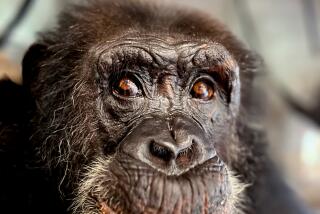Man, Chimp Separated by Dab of DNA
- Share via
Answering a key part of the age-old question of what makes us human, scientists on Wednesday unveiled a genetic comparison of people and chimps, revealing that changes to a mere sliver of DNA make it possible for us to walk upright, compose piano concertos and fall victim to cancer.
Those changes amount to 200,000 of the 3 billion chemical letters that make up the human genetic code that have occurred in the 6 million years since Homo sapiens and chimpanzees diverged from a common ancestor -- a relative blip in the history of life on Earth.
Like other mammals, humans and chimps have seen rapid evolution in genes related to immune response, reproduction and smell. But humans and chimps have outpaced other mammals in evolving sophisticated genes related to hearing and brain function, the researchers found.
Researchers also identified six regions where genetic mutations appear to have spread rapidly throughout the human population in the last 200,000 years.
One of those regions contains a gene, FOXP2, that is associated with speech development in humans.
Another hot area has been associated with obesity.
In the interconnected world of genetics, the myriad mutations have also made humans susceptible to cancer, Alzheimer’s disease, malaria, AIDS and other ailments that don’t occur in chimps, said Dr. Robert Waterston, chairman of the Department of Genome Sciences at the University of Washington School of Medicine in Seattle and a leader in the study.
The results, published in a flurry of papers in the journals Nature and Science, provide a roadmap for studying diseases and the mechanisms by which humans evolved into the dominant species of Earth.
“This is telling us about those changes that make us human,” said Eric Lander, director of the Broad Institute of MIT and Harvard University in Cambridge, Mass., one of 67 researchers in five countries who worked on the project.
The chimp DNA was taken from a male named Clint at the Yerkes National Primate Research Center in Atlanta. He died last year of heart failure at age 24.
The resulting genome overlaps with 96% of the human genome, and the corresponding sequences are 99% identical, the researchers found.
That high degree of similarity is what makes the chimp genome useful in studying human DNA.
“The human genome itself is just a parts list,” Lander said. “The human genome with the chimp genome tells us how these parts have changed.”
The scientists found a total of 40 million genetic differences between humans and chimps. About 35 million involved a change in a single DNA nucleotide, commonly known by the letters A, T, C and G. The remaining 5 million discrepancies involved genes that were inserted or deleted in either the human or chimp genome.
Most mutations are of little consequence, occurring in the vast regions of the genome that are not used to make proteins. Only about 200,000 of the mutations are in the functional part of the genome, Lander said.
The overwhelming similarity of the human and chimp genomes, and the incremental nature of the changes that set them on different developmental paths, validate the mechanics of evolution, project researchers said.
At a time when the theory of evolution is under attack by proponents of “intelligent design,” Dr. Francis S. Collins, director of the National Human Genome Research Institute, said he could not think of a better way to prove the theory of evolution “short of a time machine.”
The genome research agency, part of the National Institutes of Health, funded the study at a cost of $20 million to $30 million.
The scientists found that evolution was more flexible -- and in some ways simpler -- than many had previously thought.
There has been a debate about whether evolutionary advances depend on big changes in a few genes, or small changes in many genes.
Dr. Christopher A. Walsh, a neurology professor at Harvard Medical School, said the studies showed that a small number of changes were enough, demonstrating the power of evolution to respond to circumstances.
“You don’t have to wait for 100 different changes to occur simultaneously for something to happen,” Walsh said.
Scientists found six areas of the human genome that were overcome with mutations during a period of rapid and widespread change, an event called a “selective sweep.” These areas are remarkably similar, indicating that the changes occurred roughly within the last 200,000 years.
As an example, Landers cited the emergence of the gene for digesting lactose, which allows humans to drink milk from animals. The mutation would confer an evolutionary advantage, helping it to spread quickly and maintain its original form.
Researchers still don’t know the significance of the selective sweeps they identified. But in studying them, they can make inferences about disease outbreaks and other events that would have sparked such vast genetic change, said Evan Eichler, a geneticist at the University of Washington who worked on the study.
Research groups around the world are now tackling different pieces of the human genome in the hopes of unraveling the complexities of disease and the forces that shaped human development.
“Maybe in 20, 30, 40, 50 years it will tell us why our brains are twice as big,” said Richard K. Wilson, director of the Genome Sequencing Center at Washington University School of Medicine in St. Louis. “This is a place to start trying to answer those questions.”
But Collins, of the National Human Genome Research Institute, cautioned that genes could not solve all of the mysteries of life.
“The real question about what it takes to be human is more than a biological question, it’s also a theological question,” Collins said. DNA “may not tell us ‘How do we know what’s right and wrong?’ and ‘What’s the human spirit, anyway?’ ”







